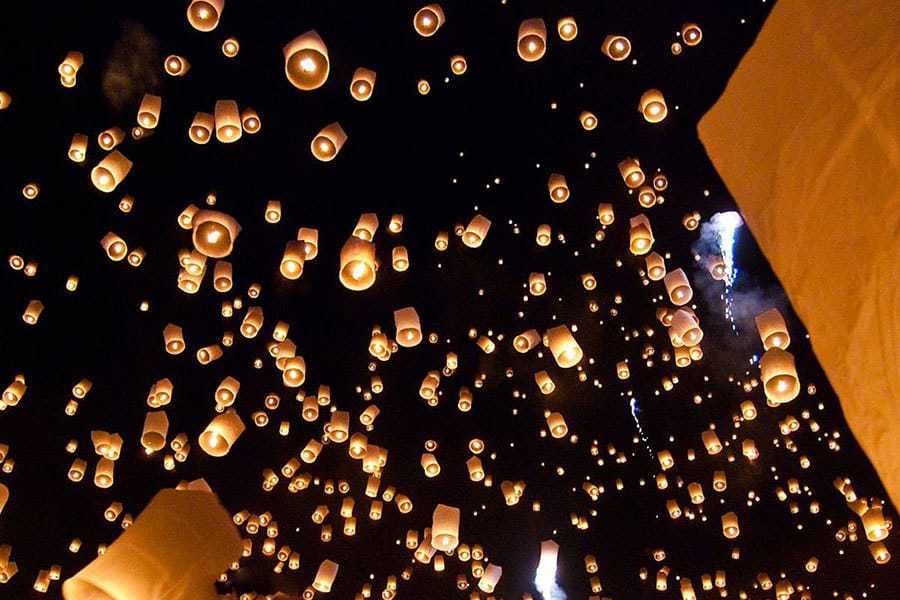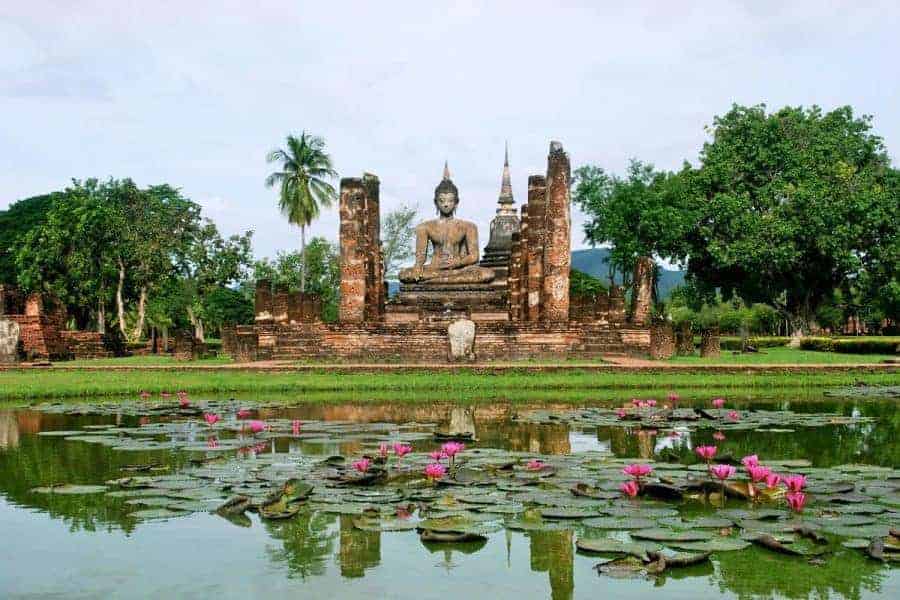If you’re seeking some real Thai culture and are craving an insight into Thailand’s fascinating history, visit the majestic and unforgettable Sukhothai Historical Park.
It’s part of the UNESCO World Heritage Sites and is located in the old part of Sukhothai, a small and vivid town in Central Thailand.
The old city of Sukhothai rose under the reign of King Ramkamheng who is considered by all Thais to be the father of their nation.
The ruins found here showcase examples of stunning early Thai architecture and include a number of very well preserved temples, Buddha statues and stupas, all of them built in what came to be known to as the Sukhothai architectural style.
Various other influences in architecture coming from the Khmers, Ceylonese and earlier local Siamese styles can also be noticed.
The stone inscriptions found in the old city of Sukhothai are considered to be the first exponents of Thai writing and illustrate examples from the administrative, social, political and economic life of that era.
Where to Stay in Sukhothai
At Home Sukhothai – A 50- years-old wooden house located in the new city of Sukhothai and offers fanned/ air-conditioned rooms and bungalows at low prices, ranging between 250 baht and 575 baht.
The hostel staff are super friendly and all guests are offered a delicious free breakfast. The walls are kind of thin, so light sleepers may struggle to sleep here without earplugs. Having said that, it does give one a great sense of familiarity with your fellow travellers!
TR Guesthouse – Offering the possibility to choose between rooms in a guesthouse or private bungalows, TR Guesthouse is situated in a quiet area around 2 km away from the bus terminal and 20 km away from the old city of Sukhothai.
The staff are very friendly and helpful at all times, the breakfast is a good deal for the money and there is a truck stop within walking distance for those heading to the historical park.
They have room service and laundry but the Wi-Fi can be poor at times, also make sure you come prepared to deal with annoying mosquitoes in Thailand! Prices range from 300-600 baht/room-bungalow.
Pai Sukhothai Resort – Located in the new city of Sukhothai and has double or twin rooms, triple rooms and bungalows. Their restaurant serves both Thai and Western dishes and the resort is close to a nice pub with live music.
The swimming pool is the main attraction in this place and the staff are super-lovely, although some of them don`t speak English very well so things can get lost in translation at times! Keep it short and clear when expressing needs and check they understand what you want afterwards!
Click Here to Check out More Accommodation in Sukhothai!

Things to do in Sukhothai
Visit Sukhothai Historical Park
The Historical Park is divided into five areas: the central, south, east, west and north and although many tourists chose to explore only the central part some of the oldest and finest ruins are to be found in the other areas.
East
You’ll find Wat Tra Phang Thong next to the museum and the serene lotus-filled pond. On the waters of this reservoir floated the first krathongs (paper lantern boats) – here is where the Loy Krathong Festival was born.
Central
The central area is considered to be the main tourist attraction because the most important and impressive ruins are located here. The ruins of Wat Mahatat and The Royal Palace of old Sukhothai Kingdom rise majestically behind a gorgeous lotus pound, Wat Mahatat is believed to be the place where Buddha`s relics were hidden after they were brought back from Ceylon.
Wat Si Sawai evokes the exotic Khmer architectural masterpieces from Angkor Wat. The imposing statue of King Ramkamhaeng reminds everyone that he was a great ruler with no equivalent in Thai history and culture even to this day. Wat Sorasak with its elephant heads that are thought to be holy spirits meant to support Mount Meru, the Centre of the Universe, is another temple worth seeing in this area.
South
Wat Chetupon is one of the most important monasteries from the old Sukhothai Kingdom. It contains a well preserved Buddha statue in walking posture in the south area of Sukhothai Historical Park.
West
In the West area Wat Sapan Hin you can find the temple where King Ramkhamhaeng the Great rode his elephant for every Buddhist Saabath in order to worship the huge Buddha statue.
North
Wat Phra Phai Luang, also called the Monastery of the Great Wind, should not be missed when exploring the North area. This temple contains standing, walking and reclining representations of Buddha and over thirty ancient stupas.
Wat Si Chum can be found behind Wat Phra Phai Luang and its 15 meters tall Buddha statue is seen daily by people from all over the world, whose picture you can also find on perhaps one of the most famous postcards sent from Thailand.

Photo Credit Here
Cycle around the park
There is no better way to make your way through the ancient ruins of Sukhothai Historical Park than cycling. The park is divided into five areas and unless you cycle or go by motorbike there is no way to see all the ruins. There is an extra fee to take a motorbike or a bicycle inside.
Trek to Wat Saphan Hin
The 300 meters long staircase that guides your way to the top of a 200 m high hill ends in front of one of the most important temples found in the Historical Park of Sukhothai. This temple is believed to be the temple that king Ramkamhaeng venerated the most and going up there gives you the opportunity to see the park`s surroundings from above.

Visit King Ramkhamhaeng National Museum
Located near the entrance of the historical park`s central area the museum gives you the chance to discover and understand the historical background of that era and how King Ramkhamhaeng came to be a ruler. The museum also hosts an interesting collection of artefacts and a replica of the earliest example of Thai writing. The museum is open daily from 9 am to 4 pm and the entrance fee is 150 baht.
Visit Sangkhalok Museum
Situated 2.5 km away from the New city of Sukhothai this museum gathers a collection of ceramics and pottery, traditional products from this region. It opens every day from 8 am to 5 pm and the admission ticket is low priced.
Experience Loy Krathong Festival
If you happen to be in Thailand during November you might want to consider the idea of heading to Sukhothai to take part in one of the most beautiful and traditional festivals in Thailand: Loy Krathong. Because Sukhothai is the birthplace of Loy Krathong, they go all out and you’ll be able to feel a strong connection to the past!

How to get to Sukhothai
The town of Sukhothai is situated in Central Thailand and this makes it accessible no matter if you start your trip from down south or the north of Thailand.
Bus from Chiang Mai – Start your trip at the Arcade Bus Station in Chiang Mai. VIP and second class buses depart every hour with a high frequency between 6 pm and 2 am and there is no need to book a ticket in advance, just go to the bus station thirty minutes before the desired departure time and you can buy your ticket on the spot. The journey lasts 5-6 hours and the buses stop in Tak for a longer break before reaching the destination.
Bus from Bangkok – VIP and second class buses depart from Mo Chit bus station daily and the journey lasts around 7 hours.
Car – Sukhothai can be easily reached by car from Bangkok, Chiang Mai, Chiang Rai or any other region in Thailand. This is one of the best ways to see rural Thailand and experience its wonders while being on the road. If you have enough time and are not on a strict schedule going to Sukhothai by car gives you the freedom to stop along the way and visit other interesting places and temples in Thailand.
Plane – From Bangkok- There are daily flights with Bangkok Airways. The flights last one hour and the airport in Sukhothai is situated 40 km outside the city.
Train – From Bangkok or Chiang Mai- There are no direct trains to Sukhothai, however, you can take the train to the near town of Phitsanulok and then travel from there to Sukhothai by bus.
You can search timetables and book local buses through our service here.
Where to Go Next
Si Satchanalai and Kamphaeng Phet – These are the two historical towns associated with Sukhothai. If Sukhothai were the political and administrative centre of the old Kingdom of Siam, Si Satchanalai would be the spiritual centre while Kamphaeng Phet would have been built for military and protective purposes. This trip is for those who desire to experience in more depth Thailand`s hidden treasures and get off the beaten track.
Ayutthaya – Another Thai ancient city classified as a UNESCO World Heritage Site. It is located very close to Bangkok and if you are interested in seeing more ruins and ancient Buddhist temples this is one destination you shouldn’t miss.
Bangkok – From Sukhothai, you can head down south to Bangkok to spend a few days in one of the craziest and most colourful cities in the world. From Bangkok, you can make your way to the islands found in the South of Thailand or even to another country as this city is also an important hub for travellers.
Kanchanaburi – If you are looking for the next adventure you might want to check out Kanchanaburi. A visit to the Erawan Waterfalls, the Death Railway and the Hellfire Pass will spice things up for you during your stay. River Kwai Bridge and Museum is also worth a visit.
Chiang Mai – The Rose of the North as some people like to call it, Chiang Mai is situated at a 6 hours bus ride away from Sukhothai and it is one of the most beautiful and chilled locations, not only in Thailand but in whole South East Asia. A heaven for Digital Nomads, English teachers, hippies and backpackers, Chiang Mai will fascinate you from the first moment you set foot on its grounds.
About the author: This article was written by Surugiu Catalina. Cat is a traveller, freelance writer and co-founder of Buddhahood Culture, a community of writers, teachers, travellers, activists, humanitarians, healers, artists and musicians, dedicated to compiling a wealth of knowledge for those who choose to walk the path of self-awareness and compassion.
